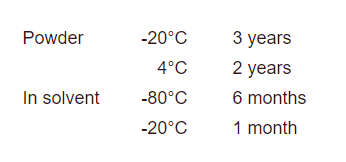Description
Mirdametinib | HY-10254
Mirdametinib (PD0325901) is an orally active, selective and non-ATP-competitive MEK inhibitor with an IC50 of 0.33 nM. Mirdametinib exhibits a Kiapp of 1 nM against activated MEK1 and MEK2. Mirdametinib suppresses the expression of p-ERK1/2 and induces apoptosis. Mirdametinib has anti-cancer activity for a broad spectrum of human tumor xenografts[1][2][3].
IC50 & Target :

In Vitro:
Mirdametinib (PD325901; 0.0064, 0.032, 0.16, 0.8, 4, 20, 100 nM; for 2 days) inhibits the growth of Papillary thyroid carcinomas (PTC) cell lines (TPC-1 cells and K2 cells) with GC50 of 11 nM and 6.3 nM, respectively[3].
Mirdametinib (100 nmol/L; for 4 days) induces apoptosis in K2 cells (top) or TPC-1 cells[3].
Mirdametinib (0.1, 1, 10, 100, 1000 nM; for 1 hour) suppresses the expression of p-ERK1/2 in K2 cells (top) or TPC-1 cells[3].
Mirdametinib prevents the growth of melanoma cell lines. Mirdametinib significantly prevents the the growth of PTC cells harboring a BRAF mutation at very low concentration (10 nM)[3].
In Vivo:
Mirdametinib (25 mg/kg, p.o.) inhibits phosphorylation of ERK by more than 50% at 24 hours post-dosing. Mirdametinib (25 mg/kg/day; po) produces a 70% incidence of complete tumor responses (C26 model)[2].
Mirdametinib (20-25 mg/kg/day; oral gavage; for 3 weeks (5 consecutive days/week)) suppresses tumor growth completely in mice inoculated with PTC cells carrying a BRAF mutation (K2) and significantly decreased tumor growth in mice inoculated with PTC cells carrying the RET/PTC1 rearrangement (TPC-1) in athymic Ncr-nu/nu mice at ages 6 to 8 weeks[3].
Molecular weight:
482.19
Formula:
C16H14F3IN2O4
SMILES:
O=C(C1=CC=C(C(F)=C1NC2=CC=C(I)C=C2F)F)NOC[C@H](O)CO
Storage:







